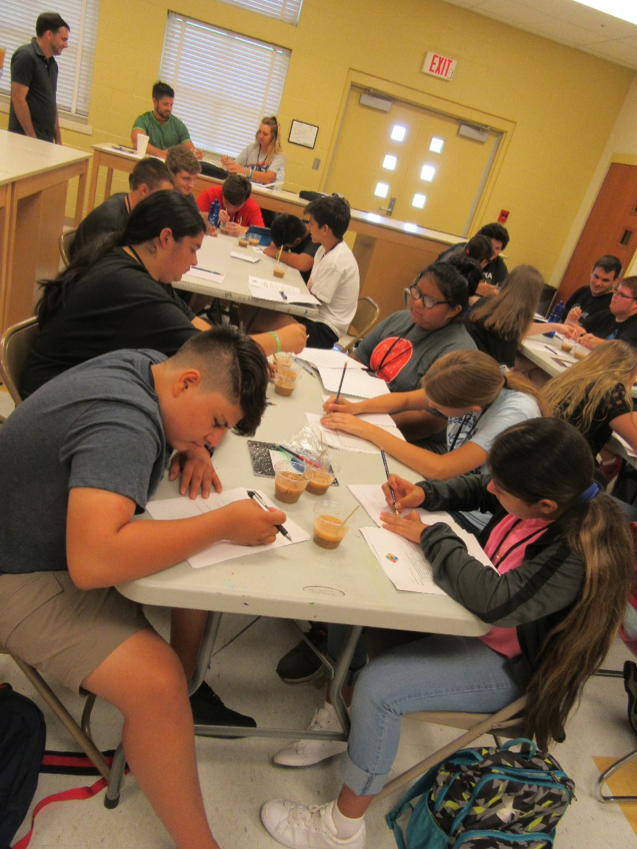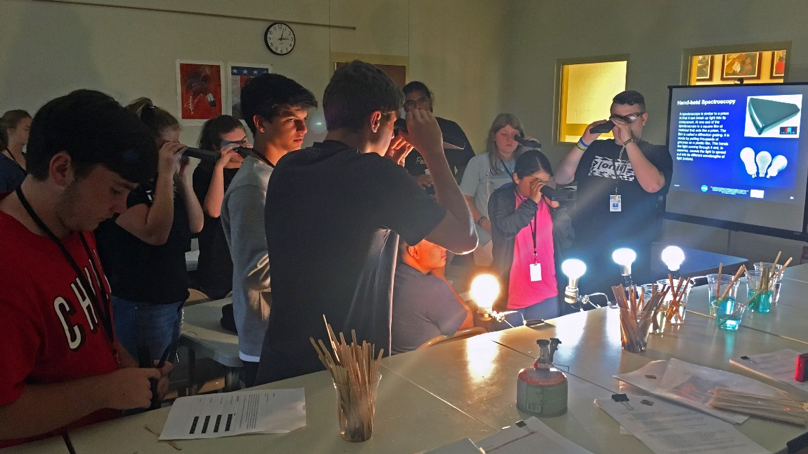-
NASA Choctaw & Chickasaw Nation STEM Camps
April 29, 2019 / Written by: Yael Kovo
Drs. Christopher Materese and Gustavo Cruz-Diaz pose with Chickasaw students at the Chickasaw Nation Aviation and Space Academy (CNASA). NASA Ames NAI team participation in the STEM camp is provided through funding from NASA’s Astrobiology Institute CAN 7 grants program. Image credit: ARC NAI CAN7 TeamIn 2018, Drs. Gustavo Cruz-Diaz and Christopher Materese of the NAI Ames CAN 7 Team participated in the Chickasaw Nation Aviation and Space Academy (CNASA) held in Ada, Oklahoma. The Chickasaw Nation has been conducting this week-long camp over the past four summers, in order to encourage their Native American youth to consider careers in the STEM (Science, Technology, Engineering, and Mathematics) fields.
Their presentation included hands-on science demonstrations, teaching them about molecular properties, chromatography, spectroscopy, refractive properties of light, and electromagnetism. The students were very interested in the presentation, in particular, those related to the search for life on other Solar System objects and on exoplanets. the flame test and building an electric motor, were among the most popular hands-on demonstrations. The students report enjoying this program very much, and some have been returning year after year.
Students have shown statistically significant improvement in their understanding of the science concepts presented by the Ames team.
“Oklahoma isn’t, especially the rural parts that we work with, generally considered to be a hub for STEM. However, we’re doing our small part to change that! Without which most of the students in our program wouldn’t have access to this type of exposure. That’s a huge reason why partnerships like those with NASA Ames Research Center are priceless. It may seem trivial to some, but I can assure you that when our students hear that scientists from NASA are making a special trip, for them, their eyes light up.” (Mr. Luke Kerr, program manager for CNASA, about their partnership with NASA Ames’ NAI CAN 7 team, 2017)

Choctaw students analyze three samples to determine which one of the three has the necessary characteristics of life. Image credit: ARC NAI CAN7 Team
Choctaw students use handheld spectroscopes to distinguish the light spectrum between incandescent, compact fluorescent and LED light bulbs. Image credit: ARC NAI CAN7 TeamSource: [ARC NAI CAN7 Team]
- The NASA Astrobiology Institute Concludes Its 20-year Tenure
- Global Geomorphologic Map of Titan
- Molecular Cousins Discovered on Titan
- Interdisciplinary Consortia for Astrobiology Research (ICAR)
- The NASA Astrobiology Science Forum Talks Now on YouTube
- The NASA Astrobiology Science Forum: The Origin, Evolution, Distribution and Future of Astrobiology
- Alternative Earths
- Drilling for Rock-Powered Life
- Imagining a Living Universe
- Workshops Without Walls: Astrovirology